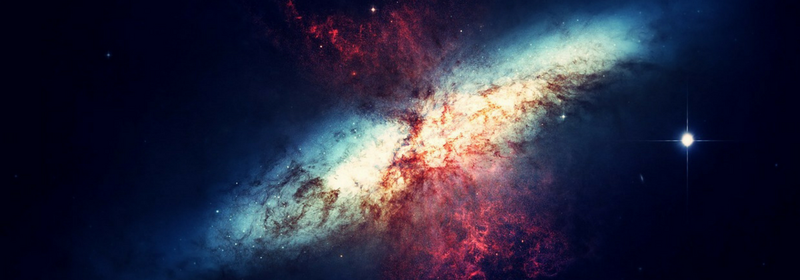
Supermassive Black Holes: Monsters in the Dark
Article Header
« Return to Main PageSupermassive Black Holes: Monsters in the Dark
by Maxwell Lorentz
 Over 2 billion light years away, there lies a galaxy named Hercules A. At its heart lurks a supermassive black hole, and it is a monster—billions of times more massive than the sun, and a hundred billion times brighter than the sun—one of the most powerful objects in the Universe.
Over 2 billion light years away, there lies a galaxy named Hercules A. At its heart lurks a supermassive black hole, and it is a monster—billions of times more massive than the sun, and a hundred billion times brighter than the sun—one of the most powerful objects in the Universe.
Supermassive black holes are always massive (by definition), but they’re not always as bright as the one in Hercules A. Often they are quite dark, lurking silently in space. In fact, astronomers think that most galaxies—and maybe even all galaxies—harbor one of these monsters at the center. Even our own galaxy, the Milky Way, has one at its heart.
Black holes are places in space where gravity is so strong that not even light can escape. They form when massive stars run out of fuel and collapse. But this collapse-process forms only “ordinary-sized” black holes—up to twenty times the mass of the sun. Supermassive black holes are much bigger—millions (and often billions) of times the sun’s mass. But astronomers can discover them the same way they find other black holes—by watching for the effects of their gravity. For example, scientists discovered the Milky Way’s own central black hole [1] by measuring the orbits of nearby stars—and then from these orbits they could figure out its gravity and then calculate its mass.
 Our own monster black hole is dark and (mostly) quiet, because there’s not much nearby gas for its gravity to pull in. But the black hole in Hercules A is 600 times heavier than our own. And, there is a lot of nearby gas to feed it—so much, that the gas swirling into the black hole forms a disk, which heats up and becomes unbelievably bright. (If the sun were as bright as this disk, it would vaporize the earth.) Even more amazing, some of the gas misses the black hole and (because of magnetic forces) shoots out in two back-to-back jets. These jets travel almost the speed of light, and they blast through space for almost a million light years (which is a distance ten times bigger than our whole galaxy).
Our own monster black hole is dark and (mostly) quiet, because there’s not much nearby gas for its gravity to pull in. But the black hole in Hercules A is 600 times heavier than our own. And, there is a lot of nearby gas to feed it—so much, that the gas swirling into the black hole forms a disk, which heats up and becomes unbelievably bright. (If the sun were as bright as this disk, it would vaporize the earth.) Even more amazing, some of the gas misses the black hole and (because of magnetic forces) shoots out in two back-to-back jets. These jets travel almost the speed of light, and they blast through space for almost a million light years (which is a distance ten times bigger than our whole galaxy).
 Hercules A is a spectacular example of an active galactic nucleus. Another good example is the galaxy Centaurus A (see the next picture). Active galaxies like these are some of the brightest powerhouses in the universe. We call the most luminous ones quasars [2]—they are blazing beacons that telescopes can see from across the entire universe. One of these quasars (named TON 618) is over 10 billion light years away, and its supermassive black hole is 15,000 times bigger than the one in our own galaxy. In fact, if you put a quasar like this at the center of our galaxy, it would shine as bright as the full moon, but all of its brightness would be concentrated into a single point. It would be a spectacular sight—but also quite dangerous to life on earth. This is one reason we can be thankful that God designed the Milky Way’s center to not have so much gas—and also put us far away from the center (which can be a dangerous place).
Hercules A is a spectacular example of an active galactic nucleus. Another good example is the galaxy Centaurus A (see the next picture). Active galaxies like these are some of the brightest powerhouses in the universe. We call the most luminous ones quasars [2]—they are blazing beacons that telescopes can see from across the entire universe. One of these quasars (named TON 618) is over 10 billion light years away, and its supermassive black hole is 15,000 times bigger than the one in our own galaxy. In fact, if you put a quasar like this at the center of our galaxy, it would shine as bright as the full moon, but all of its brightness would be concentrated into a single point. It would be a spectacular sight—but also quite dangerous to life on earth. This is one reason we can be thankful that God designed the Milky Way’s center to not have so much gas—and also put us far away from the center (which can be a dangerous place).
There’s evidence that galaxies and their supermassive black holes affect each other. When two galaxies merge, the gravitational forces can funnel a lot of gas to the center and turn the central black hole into an active galactic nucleus. And many astronomers think that once it turns on, the active black hole can blast the rest of the gas out of the galaxy altogether. This process—the “feedback” between galaxies and their supermassive black holes—is an area of ongoing research.
But how do supermassive black holes form in the first place? Scientists aren’t sure. If they form like other black holes (when a star runs out of fuel and then collapses), it would have to grow hundreds of thousands of times bigger to become a supermassive monster. And even if you had billions of years, it would end up being hard (though not quite impossible) to get supermassive black holes big enough. So, on the one hand, it’s possible that God created them directly, instead of using the same process He uses to make “ordinary” black holes. On the other hand, more research might uncover a natural process that forms them. But either way—whether He created them directly, or whether He creates them using a process—God is the Maker and Ruler of these mighty, awesome powerhouses.
In Job 26:14, after describing God’s powerful works of creation, Job says,
And these are but the outer fringe of his works;
how faint the whisper we hear of him!
Who then can understand the thunder of his power? (NIV)
Even active galactic nuclei and supermassive black holes “are but the outer fringe” of God’s works, and the whisper—not the thunder—of His power. And that is why the only appropriate response to the study of astronomy is to fall down in awe, reverence, and love—and to worship the One who made the earth and the heavens and all that is in them.
Hercules A. Image Credit: NASA, ESA, S. Baum and C. O'Dea (RIT), R. Perley and W. Cotton (NRAO/AUI/NSF), and the Hubble Heritage Team (STScI/AURA): http://www.spacetelescope.org/images/opo1247a/
Centaurus A. Image credit: X-ray - NASA, CXC, R.Kraft (CfA), et al.; Radio - NSF, VLA, M.Hardcastle (U Hertfordshire) et al.; Optical - ESO, M.Rejkuba (ESO-Garching) et al.
[1] Our galaxy’s black hole weighs in at a quite modest 4 million solar masses.
[2] Or, more precisely, quasi-stellar objects (QSOs)









